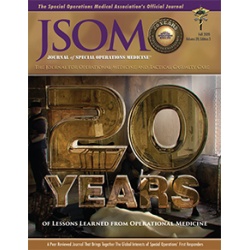Ketamine Administration by Special Operations Medical Personnel During Training Mishaps
Fisher AD, Schwartz DS, Petersen CD, Meyer SE, Thielemann JN, Redman TT, Rush SC 20(3). 81 - 86 (Journal Article)
Background: Opioids can have adverse effects on casualties in hemorrhagic shock. In 2014, the Committee on Tactical Combat Casualty Care (CoTCCC) recommended the use of ketamine at the point of injury (POI). Despite these recommendations the adherence is moderate at best. Poor use may stem from a lack of access to use ketamine during training. The United States Special Operations Command (USSOCOM) is often in a unique position, they maintain narcotics for use during all training events and operations. The goal of this work is to demonstrate that ketamine is safe and effective in both training and operational environments. Methods: This was a retrospective, observational performance improvement project within United States Special Operations Command and Air Combat Command that included the US Army's 75th Ranger Regiment, 160th Special Operations Aviation Regiment, and US Air Force Pararescue. Descriptive statistics were used to calculate the doses per administration to include the interquartile range (IQR), standard deviation (SD) and the range of likely doses using a 95% confidence interval (CI). A Wilcoxon signed-rank test was used to compare the mean pre-ketamine pain scores to the mean post-ketamine on a 0-to-10 pain scale. Results: From July 2010 to October 2017, there was a total of 34 patients; all were male. A total of 22 (64.7%) received intravenous ketamine and 12 (35.3%) received intramuscular ketamine and 8 (23.5%) received intranasal ketamine. The mean number of ketamine doses via all routes administered to patients was 1.88 (SD 1.094) and the mean total dose of all ketamine administration was 90.29mg (95% CI, 70.09-110.49). The mean initial dose of all ketamine administration was 47.35mg (95% CI, 38.52-56.18). The median preketamine pain scale for casualties was noted to be 8.0 (IQR 3) and the median post-ketamine pain scale was 0.0 (IQR 3). Conclusion: Ketamine appears to be safe and effective for use during military training accidents. Military units should consider allowing their medics to carry and use as needed.


 Español
Español 




